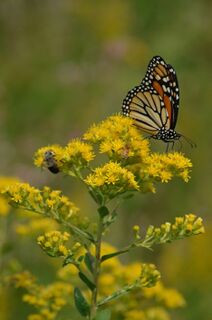Solidago rigida
| Solidago rigida | |
 | |
| Light: | |
| Moisture: | |
| Hardiness: | 4 |
| Soil pH: | 5.6-8.4 |
| Height: | 4' |
| Blooms: | Early Fall |
| Native to: | |
| Shelter | |
| Medicinal Rating: | |
| Tea: | Yes |
Solidago rigida (common name: stiff goldenrod)
Propagation: Seed - sow spring in a cold frame. Only just cover the seed and do not allow the compost to become dry. Prick out the seedlings into individual pots when they are large enough to handle, and grow them on for their first winter in pots. Plant them out into their permanent positions in spring or early summer.
Division in spring or autumn. Larger divisions can be planted out direct into their permanent positions. We have found it best to pot up the smaller divisions and grow them on in a lightly shaded position in a cold frame, planting them out once they are well established in the summer.
Cultivation: Succeeds in any moderately fertile moisture retentive soil in sun or semi-shade[1]. Grows well in heavy clay soils.
A rather greedy plant, it is apt to impoverish the soil[2].
The plant attracts various beneficial insects such as ladybirds, lacewings and hoverflies to the garden, these insects will help to control insect pests in the garden[3][4].
Range: Eastern N. America - Ontario to Saskatchewan, south to Massachusetts, Georgia, Texas and Colorado.
Habitat: Dry or gravelly open woods, thickets and prairies[5].
Medicinal: The leaves and blossoms are antiseptic, astringent and styptic[6][7]. A valuable remedy in the treatment of all kinds of haemorrhages[6]. The flowers have been ground into a lotion and used to treat bee stings[8][9].
An oil obtained from the plant (is this an essential oil?) is diuretic[6].
The root is cathartic and diuretic[9]. A decoction of the root has been used as an enema[9]. An infusion has been used to restore the flow of urine[9].
Usage: A good quality rubber can be made from a latex that is obtained from the leaves[10][11].
Mustard, orange and brown dyes can be obtained from the whole plant[7].
Pollinators: Insects
Soil: Can grow in light, medium, and heavy soils.
Flower Type: Hermaphrodite
Heavy Clay: Grows in heavy-clay soils.
Also Known As: Oligoneuron rigidum.
Links
References
- ↑ Huxley, Anthony. The New Royal Horticultural Society Dictionary of Gardening. MacMillan Press, 1992.
- ↑ Chittendon, Fred. RHS Dictionary of Plants. Oxford University Press, 1951.
- ↑ Allardice, Pamela. A-Z of Companion Planting. Cassell Publishers, 1993.
- ↑ Bown, Deni. Royal Horticultural Society Encyclopaedia of Herbs and Their Uses. Dorling Kindersley, 1995.
- ↑ Lyndon, Merritt. Gray's Manual of Botany. American Book Co, 1950.
- ↑ 6.0 6.1 6.2 Grieve, Margaret. A Modern Herbal. Penguin, 1984.
- ↑ 7.0 7.1 Grae, Ida. Nature's Colors. MacMillan Publishing, 1974.
- ↑ Weiner, Michael. Earth Medicine, Earth Food. Ballantine Books, 1980.
- ↑ 9.0 9.1 9.2 9.3 Moerman, Daniel. Native American Ethnobotany. Timber Press, 1998.
- ↑ Uphof, Johannes. Dictionary of Economic Plants. Weinheim, 1959.
- ↑ Usher, George. A Dictionary of Plants Used by Man. Constable, 1974.